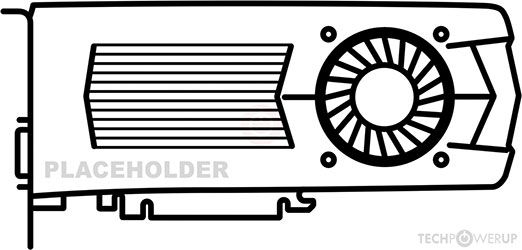Report an Error
NVIDIA PG506-242
- Graphics Processor
- GA100
- Cores
- 3584
- TMUs
- 224
- ROPs
- 96
- Memory Size
- 24 GB
- Memory Type
- HBM2
- Bus Width
- 3072 bit
The PG506-242 is a professional graphics card by NVIDIA, launched on April 12th, 2021. Built on the 7 nm process, and based on the GA100 graphics processor, the card does not support DirectX. Since PG506-242 does not support DirectX 11 or DirectX 12, it might not be able to run all the latest games. The GA100 graphics processor is a large chip with a die area of 826 mm² and 54,200 million transistors. Unlike the fully unlocked DRIVE A100 PROD, which uses the same GPU but has all 6912 shaders enabled, NVIDIA has disabled some shading units on the PG506-242 to reach the product's target shader count. It features 3584 shading units, 224 texture mapping units, and 96 ROPs. Also included are 224 tensor cores which help improve the speed of machine learning applications. NVIDIA has paired 24 GB HBM2 memory with the PG506-242, which are connected using a 3072-bit memory interface. The GPU is operating at a frequency of 930 MHz, which can be boosted up to 1440 MHz, memory is running at 1215 MHz.
Being a dual-slot card, the NVIDIA PG506-242 draws power from an 8-pin EPS power connector, with power draw rated at 165 W maximum. This device has no display connectivity, as it is not designed to have monitors connected to it. PG506-242 is connected to the rest of the system using a PCI-Express 4.0 x16 interface. The card measures 267 mm in length, 112 mm in width, and features a dual-slot cooling solution.
Being a dual-slot card, the NVIDIA PG506-242 draws power from an 8-pin EPS power connector, with power draw rated at 165 W maximum. This device has no display connectivity, as it is not designed to have monitors connected to it. PG506-242 is connected to the rest of the system using a PCI-Express 4.0 x16 interface. The card measures 267 mm in length, 112 mm in width, and features a dual-slot cooling solution.
Graphics Processor
Graphics Card
- Release Date
- Apr 12th, 2021
- Availability
- 2021
- Generation
-
Tesla Ampere
(Axx)
- Predecessor
- Tesla Turing
- Successor
- Tesla Ada
- Production
- Active
- Bus Interface
- PCIe 4.0 x16
Relative Performance
Based on TPU review data: "Performance Summary" at 1920x1080, 4K for 2080 Ti and faster.
Performance estimated based on architecture, shader count and clocks.
Clock Speeds
- Base Clock
- 930 MHz
- Boost Clock
- 1440 MHz
- Memory Clock
-
1215 MHz
2.4 Gbps effective
Memory
- Memory Size
- 24 GB
- Memory Type
- HBM2
- Memory Bus
- 3072 bit
- Bandwidth
- 933.1 GB/s
Render Config
- Shading Units
- 3584
- TMUs
- 224
- ROPs
- 96
- SM Count
- 56
- Tensor Cores
- 224
- L1 Cache
- 192 KB (per SM)
- L2 Cache
- 24 MB
Theoretical Performance
- Pixel Rate
- 138.2 GPixel/s
- Texture Rate
- 322.6 GTexel/s
- FP16 (half)
- 10.32 TFLOPS (1:1)
- FP32 (float)
- 10.32 TFLOPS
- FP64 (double)
- 5.161 TFLOPS (1:2)
Board Design
- Slot Width
- Dual-slot
- Length
- 267 mm
10.5 inches
- Width
- 112 mm
4.4 inches
- TDP
- 165 W
- Suggested PSU
- 450 W
- Outputs
- No outputs
- Power Connectors
- 8-pin EPS
- Board Number
- P1001 SKU 205
Graphics Features
- DirectX
- N/A
- OpenGL
- N/A
- OpenCL
- 3.0
- Vulkan
- N/A
- CUDA
- 8.0
- Shader Model
- N/A
GA100 GPU Notes
| Tensor Cores: 3rd Gen NVENC: No Support NVDEC: 4th Gen x5 PureVideo HD: VP10 VDPAU: Feature Set J Latest Drivers: Windows 10 / 11 (x64): Quadro Release: Latest Data Center Release: Latest |
Nov 5th, 2024 15:57 EST
change timezone
Latest GPU Drivers
New Forum Posts
- Is 60 degrees too hot for a m2 nvme pci-e 4.0? (82)
- RX580 2048SP issues (18)
- Testing ARROW lake - power limited (59)
- RX580 2048SP Game Revolution vBIOS (1)
- New RTX 5090 + 9800X3D build: ASUS TUF GAMING X670E-PLUS WIFI a good choice? (52)
- New GameTech GPU benchmark. Share your results! (136)
- Where do you buy your hardware? (67)
- What are you playing? (22120)
- Windows 11 24H2 yes or no? (146)
- Case Wiring Help - Phanteks Evolve X (0)
Popular Reviews
- Dragon Age: The Veilguard Performance Benchmark Review
- SilverStone SETA A2 Review
- DDR5 Memory Performance Scaling with AMD Zen 5
- Call of Duty: Black Ops 6 Performance Benchmark Review - AMD FTW
- Intel Core Ultra 9 285K Review
- Ocypus Iota C70 BK ARGB Review
- G-Wolves Hati-R 8K Review
- Enermax PlatiGemini 1200 W Review
- Intel Core Ultra 7 265K Review
- I\OAudio SOGNO In-Ear Monitors Review - 2 DD, 6 BA, All Harman
Controversial News Posts
- AMD Falling Behind: Radeon dGPUs Absent from Steam's Top 20 (163)
- Quick Denuvo DRM Cracks Cost Game Publishers 20% in Revenue, According to Study (136)
- AMD Introduces Next-Generation AMD Ryzen 7 9800X3D Processor, $479, Nov 7 (124)
- MSI OCLab Reveals Ryzen 9000X3D 11-13% Faster Than 7000X3D, AMD Set to Dominate "Arrow Lake" in Gaming (123)
- Apple and Samsung in the Fray to Acquire Intel: Rumor (121)
- AMD Ryzen 7 9800X3D Comes with 120W TDP, 5.20 GHz Boost, All Specs Leaked (120)
- Intel's Core Ultra 9 285K Performance Claims Leaked, Doesn't Beat i9-14900K at Gaming (114)
- NVIDIA Tunes GeForce RTX 5080 GDDR7 Memory to 32 Gbps, RTX 5070 Launches at CES (112)

